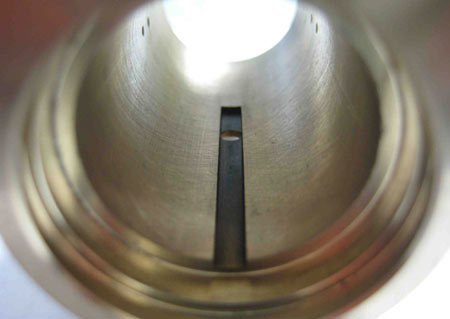Copper
 The applications of copper alloys in engines are generally those where we might expect to see relative movement or where a combination of strength, wear resistance and thermal conductivity is required. A favourite type for many of these applications are the copper-beryllium alloys.
The applications of copper alloys in engines are generally those where we might expect to see relative movement or where a combination of strength, wear resistance and thermal conductivity is required. A favourite type for many of these applications are the copper-beryllium alloys.
Beryllium is a very lightweight element, and has some attractive mechanical and physical properties. However, there are health considerations regarding its use. Copper-beryllium alloys are not felt to be a serious health concern, although some companies are looking to limit its use as a precautionary measure. Copper-beryllium alloys certainly don't represent the same health risks as aluminium-beryllium materials, where pure and finely divided beryllium is held in an aluminium matrix.
Aluminium-beryllium is banned in Formula One (which is probably one of the only race series where budgets would justify its use), but copper-beryllium alloys are within the rules. Aluminium-beryllium materials contain a large proportion of beryllium, where the typical copper-beryllium alloys found in use in race engines contain 2% or less of beryllium.
The drive to limit the use of beryllium has lead to beryllium-free alloys being developed, and these have found a number of uses in motorsport, being used as a direct replacement for copper-beryllium alloys in many applications.
A number of copper-nickel-tin 'spinodal' alloys have found use in bearing applications such as valve guides, lifter bore sleeves and so on. These alloys are said to exhibit low wear and friction, and combine low friction with a high level of yield strength. However, they do not possess the high levels of thermal conductivity required for some of the more demanding thermal applications in race engines. Where valve guides are required to remove a large proportion of heat from a valve, we would still expect to find high thermal conductivity alloys in use. The same applies to valve seats which, in most engines, will be responsible for the conduction of most of the heat away from the valve head.

Some copper moulding alloys have found widespread use in race engines where the combination of strength, wear resistance and thermal conductivity is required. The main alloying elements in such alloys are nickel, silicon and chromium. They find current use in race engines as valve seats and guides, valve-lifter sleeves (for pushrod valvetrains), con rod bushes and as bushes in engine where people are looking to replace rolling element bearings, but where no suitable bearing shell exists.
Copper-chromium alloys offer reasonable strength and very high thermal conductivity, and might find use in applications where dissipating heat is an important requirement, such as valve seats, valve guides (especially where sodium-cooled valves are used) and in highly loaded con rod bushings.

In terms of high-conductivity copper alloys being used for valve seats, it is common practice to use different materials on inlet and exhaust valve seats, with a higher conductivity alloy generally being specified for the exhaust valve seat. The two most common grades of beryllium copper in use for these components can both be replaced with beryllium-free alternatives offering very similar or higher thermal conductivity.
Fig. 1 - Valve seats can be replaced with beryllium-free alternatives that offer equivalent thermal conductivity (Courtesy of Performance Alloys and Services)
Fig. 2 - This is the bore of a valve lifter sleeve. Wear resistance is an important property for these parts (Courtesy of Performance Alloys and Services)
Written by Wayne Ward